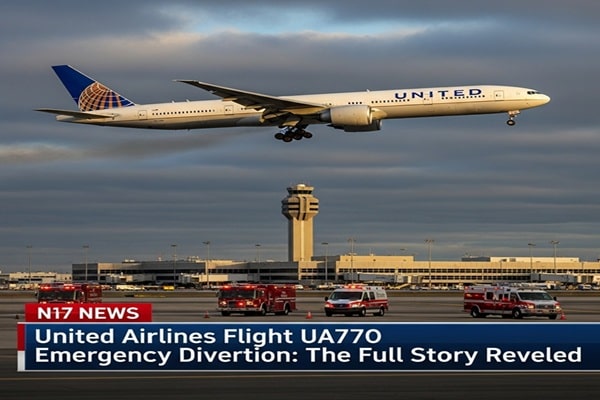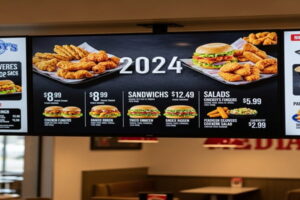
When passengers boarded United Airlines Flight UA770 from Barcelona to Chicago, no one could have guessed they’d soon be part of an unexpected mid-air drama. Yet, a few hours later, the Boeing 787-9 Dreamliner declared a full emergency — squawking the code 7700 — and diverted to London Heathrow Airport.
What followed was a remarkable display of modern aviation safety, technology, and teamwork that ensured everyone on board landed safely. Let’s unpack what really happened, what caused the diversion, and what we can learn from this gripping yet well-handled incident.
What Triggered the Emergency on Flight UA770?
About two hours into the flight, everything seemed normal. The Dreamliner was cruising smoothly over European airspace when the pilots detected a cabin pressurization issue — one of the most critical systems in any aircraft.
This wasn’t just turbulence or a technical blip. The cabin pressure suddenly changed, and passengers soon heard strange noises as oxygen masks dropped from above. At that point, the flight crew had to act fast, following strict safety protocols that prioritize maintaining breathable air levels and passenger safety.
The Moment Squawk 7700 Was Activated
If you’re wondering, “What does Squawk 7700 mean?” — it’s aviation’s universal distress signal. When the pilots entered code 7700 into the aircraft’s transponder, it immediately alerted air traffic control (ATC) across Europe that Flight UA770 was facing an emergency.
Within seconds, ATC centers in London, Paris, and Madrid received the signal. EUROCONTROL, Europe’s centralized air traffic network, prioritized the flight and began coordinating a clear path for descent. Even United’s operations team in Chicago got real-time updates about the aircraft’s condition, thanks to the Boeing 787’s advanced telemetry systems.
Signs of Trouble Mid-Flight
Passengers later shared that the first sign something was wrong came when oxygen masks dropped from the ceiling — a surefire signal that the cabin was losing pressure.
“The crew was calm. That helped a lot. But we didn’t know what was going on,”
recalled one passenger.
Despite the anxiety in the cabin, the pilots and flight attendants remained composed, reassuring travelers and taking the aircraft down to a safer, lower altitude where everyone could breathe normally.
Why London Heathrow Was Chosen for Diversion
When an aircraft declares an emergency, the nearest suitable airport becomes the target. For Flight UA770, London Heathrow checked every box:
-
Location: It was directly along the flight path.
-
Infrastructure: Heathrow’s long runways and modern facilities can handle large aircraft easily.
-
Emergency Readiness: Fire, medical, and rescue teams are available 24/7.
EUROCONTROL and British ATC coordinated a priority route in record time. In under 30 minutes, the Dreamliner had clearance to land on Runway 27R.
Inside the Aircraft: Calm Under Pressure
While pilots dealt with technical systems, the cabin crew focused on passengers. They walked the aisles, secured the cabin, and made sure everyone stayed seated. Their professionalism helped calm nerves during what could have easily become a panic situation.
Meanwhile, the Dreamliner’s built-in safety systems kicked into gear.
Boeing 787-9: Built for Emergencies
The 787 is equipped with:
-
Triple flight control computers – backups in case one fails.
-
Fly-by-wire controls – making it easier to handle the plane during stress.
-
Airplane Health Management (AHM) system – which monitors over 280,000 data points in real time.
This system sent live diagnostics to both the cockpit and United’s control center, helping engineers understand the problem instantly.
The Crew’s Response: Textbook Precision
Once the problem was identified as a cabin pressurization malfunction, the captain and first officer immediately declared the emergency and communicated with ATC.
They reviewed alternate airports, evaluated fuel, weather, and runway conditions — and chose Heathrow as the safest option.
While the pilots guided the Dreamliner toward London, flight attendants performed safety checks, secured the galley, and reassured passengers. Despite the tension, the situation remained controlled and professional throughout.
Passenger Experience During the Descent
Imagine cruising at 37,000 feet when suddenly oxygen masks drop down — that’s what happened on UA770. Some passengers later said it felt “surreal,” like a scene straight out of a movie. But even with uncertainty, the crew’s calm demeanor kept panic to a minimum.
The descent felt controlled, not chaotic. In aviation terms, this was a “controlled emergency descent”, carefully managed to balance safety and passenger comfort.
Coordinated Response on the Ground
While the crew managed the airside operations, an entire network of aviation professionals on the ground kicked into motion.
Seamless Air Traffic Control Coordination
From Spanish to French to British airspace, controllers guided UA770 without delays.
-
EUROCONTROL’s conflict resolution algorithms instantly cleared a priority corridor.
-
Weather-integrated mapping ensured the aircraft avoided turbulence or bad weather during descent.
-
Digital communication links kept every control tower informed of the aircraft’s progress.
This synchronized response demonstrated how well Europe’s aviation systems work together during crises.
Heathrow’s Emergency Protocol in Action
As soon as Heathrow received the emergency declaration, the airport went into high alert.
Here’s what happened behind the scenes:
-
Fire and rescue units positioned along Runway 27R.
-
Medical teams and paramedics were on standby.
-
Security and operations staff followed strict emergency checklists.
-
Thermal imaging vehicles prepared to scan the aircraft post-landing.
Every part of this protocol is practiced and perfected through simulation drills — ensuring real-life responses are fast and flawless.
Also Read : The Rise of Jolla PR: From Social Media Sensation to Adult Entertainment Star
A Smooth Landing and Careful Inspection
At 4:55 PM BST, United Airlines Flight UA770 touched down safely. Emergency vehicles quickly surrounded the aircraft, but there was no chaos — only calm, practiced professionalism.
Engineers and airport staff inspected the Dreamliner, focusing on the pressurization system. Once cleared, passengers were escorted off in an orderly manner. United provided alternative flight arrangements and hotel accommodations for affected travelers.
What We Learned from UA770’s Emergency Diversion
This incident is a perfect example of why modern aviation is safer than ever.
Even when things go wrong, there’s a robust system in place to protect passengers.
1. Technology Saves Lives
The 787’s real-time monitoring and redundant systems gave pilots crucial information instantly. This allowed them to make confident, data-driven decisions.
2. Training Makes All the Difference
United’s crew showed how years of crisis management training pay off. Every action — from squawking 7700 to selecting Heathrow — followed a precise plan designed to minimize risk.
3. Teamwork Is Everything
From EUROCONTROL’s coordination to Heathrow’s ground response, this event proved how many professionals are involved in keeping flights safe.
The Future of Transatlantic Flight Safety
Every emergency like UA770 adds valuable lessons to aviation safety. Airlines and manufacturers study such cases to improve:
-
Predictive maintenance systems powered by AI.
-
Better real-time data sharing between aircraft and ground stations.
-
Faster emergency routing through integrated air traffic networks.
The goal is simple — prevent emergencies before they happen.
Final Thoughts: Calm in the Skies
The safe landing of United Airlines Flight UA770 wasn’t luck — it was the result of human skill, advanced technology, and seamless coordination.
While passengers experienced moments of fear, they also witnessed firsthand how aviation safety protocols work in real life. The crew’s professionalism and the technology behind the Boeing 787 proved that even in emergencies, air travel remains incredibly safe.
Next time you board a flight, remember — every beep, every backup system, and every calm instruction from a crew member is part of a massive, well-rehearsed safety net built to protect you.


